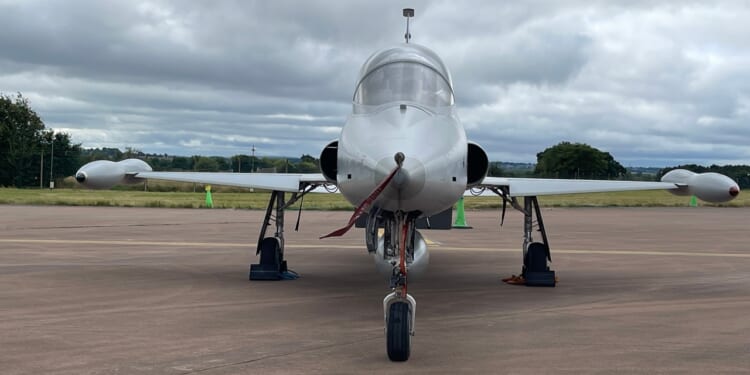Argentina has sought to procure newer fighter aircraft—but the British have consistently obstructed its efforts due to the ongoing Falkland Islands dispute.
The A-4 Skyhawk, long since retired from American service, is still flying for Argentina in an upgraded form known as the A-4AR “Fightinghawk.” The original A-4 is a product of the 1950s that reached its peak in the Vietnam-era, and which has long been replaced with fourth- and fifth-generation options. Yet Argentina, constrained for geopolitical and fiscal reasons, still flies the mid-century A-4—which has become a symbol both of Argentina’s strategic shortcomings and its resilience and resourcefulness.
The A-4AR Fightinghawk’s Specifications
- Year Introduced: 1998 (Argentina)
- Number Built: 36 delivered (32 A-4AR + 4 OA-4AR trainers)
- Length: ≈46 ft (14.1 m)
- Wingspan: ≈27.5 ft (8.4 m)
- Weight (MTOW): ≈24,500 lb (11,100 kg)
- Engine: One Pratt & Whitney J52-P-408A turbojet (~11,200 lbf thrust)
- Top Speed: ≈670 mph (1,080 km/h) / Mach 0.9
- Range: ≈1,700 nmi (1,956 mi, 3,150 km) ferry range
- Service Ceiling: ≈42,250 ft (12,880 m)
- Loadout: ≈8,200 lb of ordnance; AIM-9L Sidewinder, iron and guided bombs, AGM-65 Maverick (limited use), rockets
- Aircrew: 1 (A-4AR) or 2 (OA-4AR trainer)
Why Is Argentina Hanging on to a 1950s Fighter Jet?
The A-4AR fleet originates from a 1990s modernization program, in which the US provided Argentina with refurbished A-4M airframes, which had been significantly upgraded with late-Cold War avionics. The resultant “Nighthawk” was, in many ways, a hybrid between the rugged, compact airframe of the classic Skyhawk paired with electronics drawn from the early F-16. Upgrades included the AN/APG-66V2 radar, HOTAS controls, a modern heads-up display, new mission computers, enhanced navigation systems, and improved electronic warfare gear. Structurally, the upgraded A-4 received wiring overhauls, cockpit updates, and a strengthened airframe centered around the reliable Pratt & Whitney J52-P-408A engine.
The purpose of providing upgraded A-4s was simple: to give Argentina a modest but credible air defense and strike platform suitable for policing its vast national airspace and deterring regional threats. Initially, the A-4ARs were adequate for Argentina’s purposes. By the 2010s, however, attrition and budgetary pressures left only a small portion of the fleet airworthiness (usually between six and 12 aircraft, kept airworthy through careful maintenance and cannibalization). Regardless, the Fightinghawk remains the only true combat jet in the entire Argentine service.
The Fightinghawk’s Finest Hour Came During the Falklands War
The Argentine military is still living in the shadow of the Falklands War. During the 1982 conflict, Argentina relied on older A-4s (like the B- and C-variants). Argentine pilots used the A-4 to execute dangerous low-level strike missions, often under severe radar and missile threat from the Royal Navy. The Skyhawk’s small size, agility, and ruggedness allowed it to penetrate British defenses on multiple occasions, scoring hits on vessels including HMS Coventry and HMS Broadsword. The operations highlighted the bravery of the Argentine pilots—and also the limitations of the already outdated A-4, which lacked modern sensors, electronic warfare systems, or precision weapons.
Yet the Falklands War still influences Argentina’s procurement prospects. Multiple attempts to acquire more advanced fighters (Saab JAS 39 Gripens, F-16s, KAI FA-50s, etc) have failed, either on account of budget constraints or British export vetoes on key components due to the ongoing Falklands dispute. These geopolitical bottlenecks have effectively trapped Argentina in a cycle where the A-4AR remains the only viable short-term option.
The strategic implications of these constraints are significant. Because of them, Argentina operates a small fleet of upgraded Skyhawks, which lends only minimum deterrent capabilities. The A-4AR is adequate for air-policing, maritime patrol, and limited strike missions. But the gap between the A-4AR’s capabilities and those of regional powers, like Brazil (operating the Gripen) and Chile (operating the F-16), is widening significantly. The effect is that Argentina can police its own airspace—but has no ability to project power. Still, the enduring use of the Skyhawk in Argentina service speaks to the durability and simplicity of the aircraft’s original design.
About the Author: Harrison Kass
Harrison Kass is a senior defense and national security writer at The National Interest. Kass is an attorney and former political candidate who joined the US Air Force as a pilot trainee before being medically discharged. He focuses on military strategy, aerospace, and global security affairs. He holds a JD from the University of Oregon and a master’s in Global Journalism and International Relations from NYU.
Image: Shutterstock / Aerospace Trek.

















